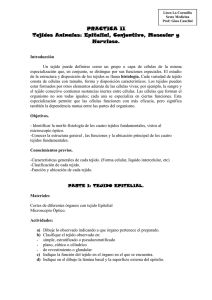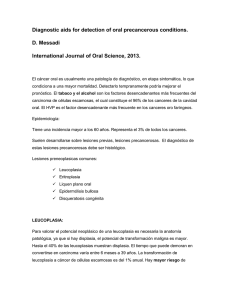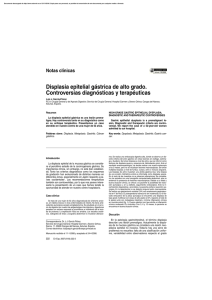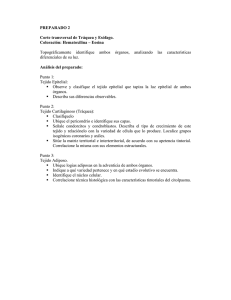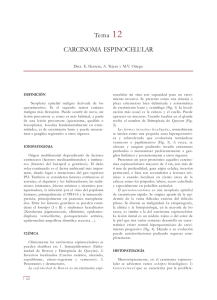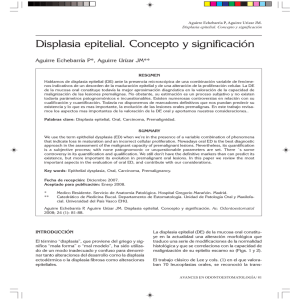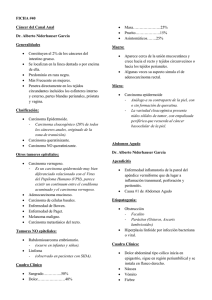comparación del porcentaje de infiltrado inflamatorio crónico entre
Anuncio
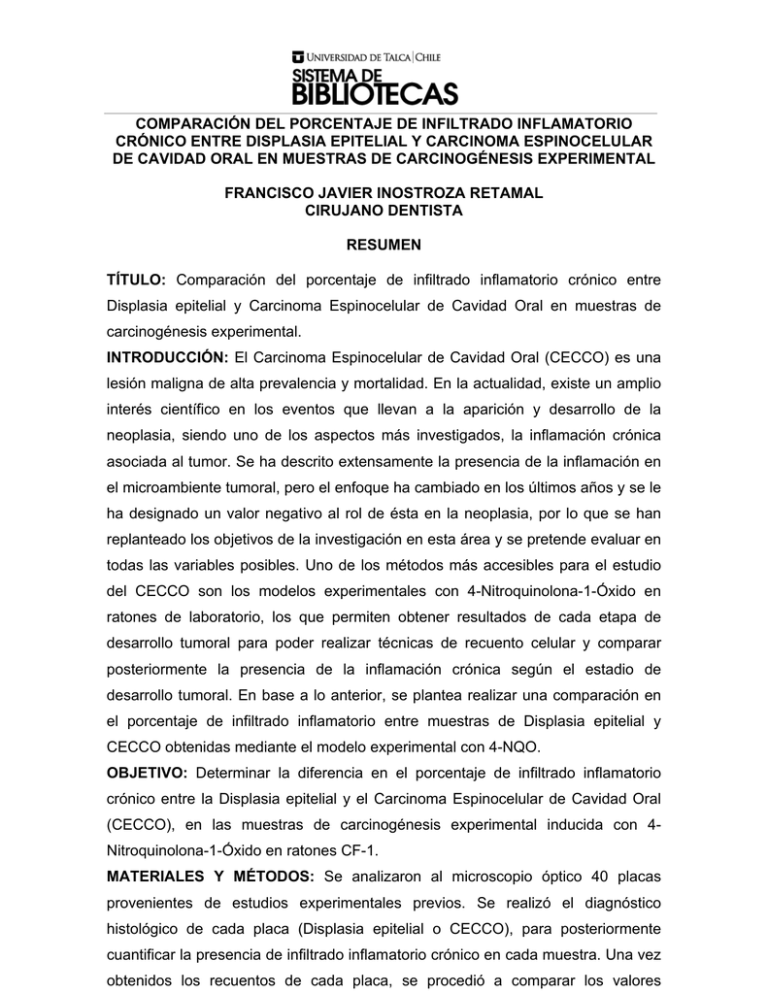
COMPARACIÓN DEL PORCENTAJE DE INFILTRADO INFLAMATORIO CRÓNICO ENTRE DISPLASIA EPITELIAL Y CARCINOMA ESPINOCELULAR DE CAVIDAD ORAL EN MUESTRAS DE CARCINOGÉNESIS EXPERIMENTAL FRANCISCO JAVIER INOSTROZA RETAMAL CIRUJANO DENTISTA RESUMEN TÍTULO: Comparación del porcentaje de infiltrado inflamatorio crónico entre Displasia epitelial y Carcinoma Espinocelular de Cavidad Oral en muestras de carcinogénesis experimental. INTRODUCCIÓN: El Carcinoma Espinocelular de Cavidad Oral (CECCO) es una lesión maligna de alta prevalencia y mortalidad. En la actualidad, existe un amplio interés científico en los eventos que llevan a la aparición y desarrollo de la neoplasia, siendo uno de los aspectos más investigados, la inflamación crónica asociada al tumor. Se ha descrito extensamente la presencia de la inflamación en el microambiente tumoral, pero el enfoque ha cambiado en los últimos años y se le ha designado un valor negativo al rol de ésta en la neoplasia, por lo que se han replanteado los objetivos de la investigación en esta área y se pretende evaluar en todas las variables posibles. Uno de los métodos más accesibles para el estudio del CECCO son los modelos experimentales con 4-Nitroquinolona-1-Óxido en ratones de laboratorio, los que permiten obtener resultados de cada etapa de desarrollo tumoral para poder realizar técnicas de recuento celular y comparar posteriormente la presencia de la inflamación crónica según el estadio de desarrollo tumoral. En base a lo anterior, se plantea realizar una comparación en el porcentaje de infiltrado inflamatorio entre muestras de Displasia epitelial y CECCO obtenidas mediante el modelo experimental con 4-NQO. OBJETIVO: Determinar la diferencia en el porcentaje de infiltrado inflamatorio crónico entre la Displasia epitelial y el Carcinoma Espinocelular de Cavidad Oral (CECCO), en las muestras de carcinogénesis experimental inducida con 4Nitroquinolona-1-Óxido en ratones CF-1. MATERIALES Y MÉTODOS: Se analizaron al microscopio óptico 40 placas provenientes de estudios experimentales previos. Se realizó el diagnóstico histológico de cada placa (Displasia epitelial o CECCO), para posteriormente cuantificar la presencia de infiltrado inflamatorio crónico en cada muestra. Una vez obtenidos los recuentos de cada placa, se procedió a comparar los valores obtenidos, distinguiendo según diagnóstico las diferencias encontradas en la cuantificación. RESULTADOS: Se encontraron diferencias estadísticamente significativas entre los porcentajes de células inflamatorias según diagnóstico, representando esta diferencia, una mayor cantidad de infiltrado inflamatorio en las muestras de CECCO que en las de Displasia epitelial (37,49 % y 16,49%, respectivamente). CONCLUSIÓN: Si existen diferencias entre el porcentaje de infiltrado inflamatorio crónico en las muestras experimentales de CECCO y Displasia epitelial, obtenidas mediante el modelo carcinogénico con 4-Nitroquinolona-1-Óxido en ratones de laboratorio. PALABRAS CLAVES: Carcinoma Espinocelular de la Cavidad Oral (CECCO), Displasia Epitelial, Carcinogénesis Química, 4-Nitroquinolona-1-Óxido (4-NQO), Inflamación Crónica, Inflamación y Cáncer, Frente de Invasión Tumoral (FIT), Recuento celular. ABSTRACT TITLE: Comparison of the percentage of Chronic Inflammatory Cells between Epithelial Dysplasia and Oral Squamous Cell Carcinoma in experimental carcinogenesis samples. INTRODUCTION: Oral Squamous Cell Carcinoma (OSCC) is a malignancy of high prevalence and mortality. Today, there is a broad scientific interest in the events leading to the emergence and development of the neoplasm, being one of the most researched aspects the chronic inflammation associated with the tumor. The presence of inflammation in the tumor microenviroment has been extensively described, but the focus has shifted in recent years, and a negative value has been designated to it. Because of that, the research objectives in this area have been reassigned; with the purpose of evaluate all the possible variables. One of the most accessible methods for the study of OSCC is the experimental model based in the use of 4-Nitroquinoline -1- oxide in laboratory mice, which can obtain the results of each stage of the tumor development with the purpose of perform cell count techniques and then compare the presence of chronic inflammation according to the stage of tumor development. In the present study, it is proposed to make a comparison in the percentage of inflammatory infiltrate between samples of Epithelial dysplasia and OSCC, obtained by the experimental model with 4 - NQO. OBJECTIVE: Determinate the difference in the percentage of chronic inflammatory infiltrate between Epithelial dysplasia and Oral Squamous Cell Carcinoma in samples of experimental carcinogenesis with 4-Nitroquinolona-1-oxide in CF-1 mice. MATERIALS AND METHODS: 40 plates from previous experimental studies were analyzed by light microscopy. The histological diagnosis of each plate (Epithelial dysplasia or OSCC) was performed, with the purpose of subsequently quantify the presence of chronic inflammatory infiltrates in each sample. Once the counts of each plate were obtained, a comparison of the values was done, distinguishing the differences in the quantification according with the diagnosis. RESULTS: Statistically significant differences between the percentage of inflammatory cells were found according to diagnosis, being expressed this difference in a greater amount of inflammatory infiltrate in OSCC samples than in epithelial dysplasia (37.49% and 16.49%, respectively) . CONCLUSION: There are differences between the percentage of chronic inflammatory infiltrate in experimental samples between OSCC and epithelial dysplasia, obtained by the carcinogenic model of 4-Nitroquinoline-1-oxide in laboratory mice. KEY WORDS: Squamous Cell Carcinoma (OSCC), Epithelial Dysplasia, Chemical Carcinogenesis, 4-Nitroquinoline-1-Oxide (4-NQO), Chronic Inflammation, Cancer related Inflammation, Tumoral Invasion Front, Cell count.
